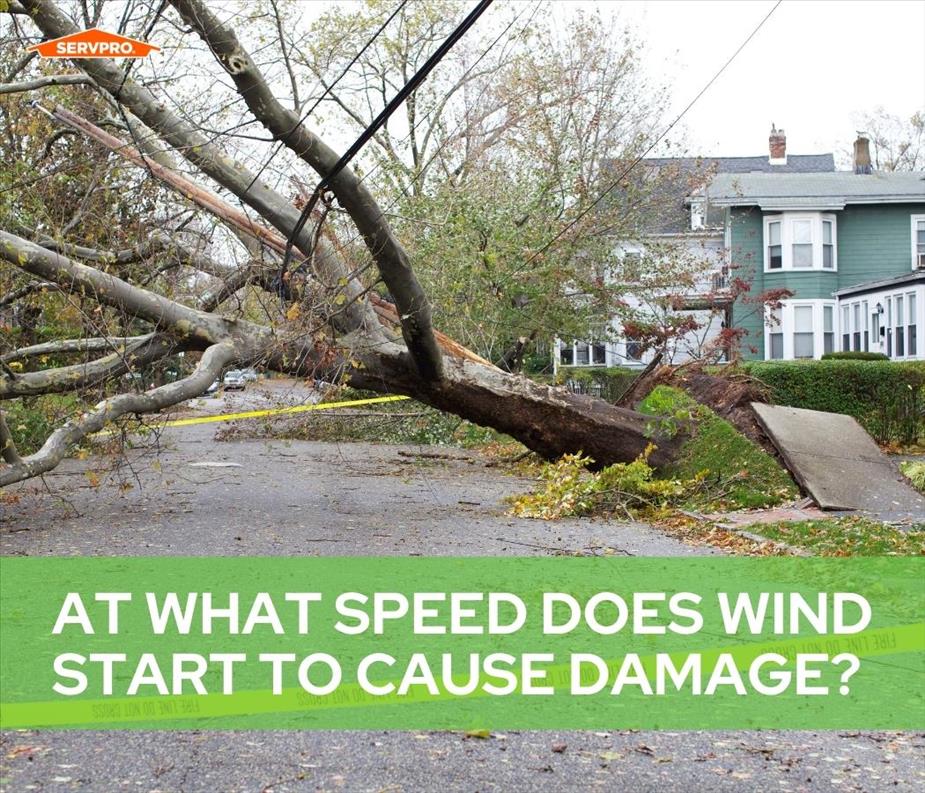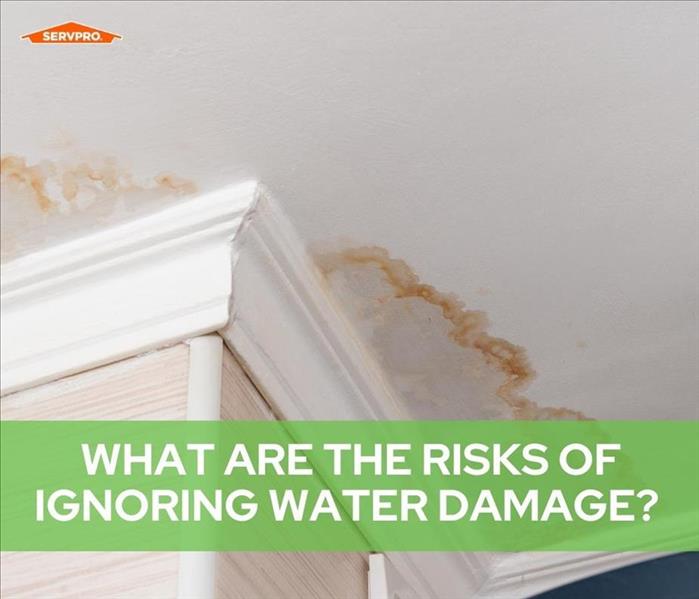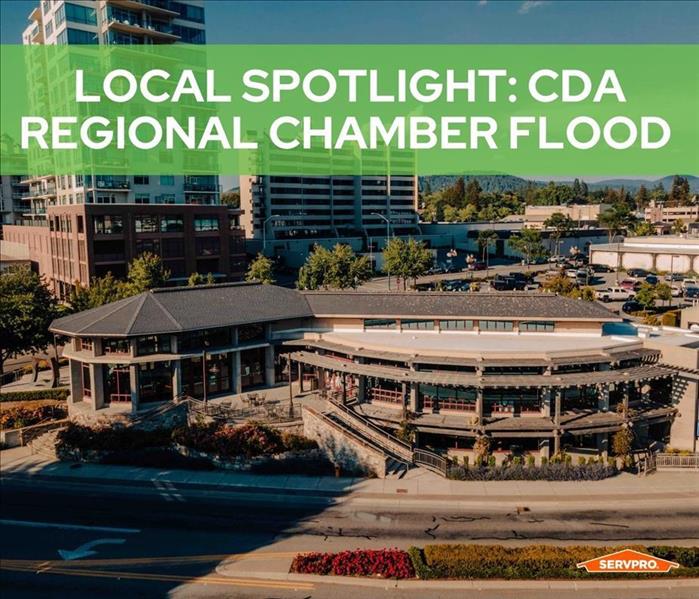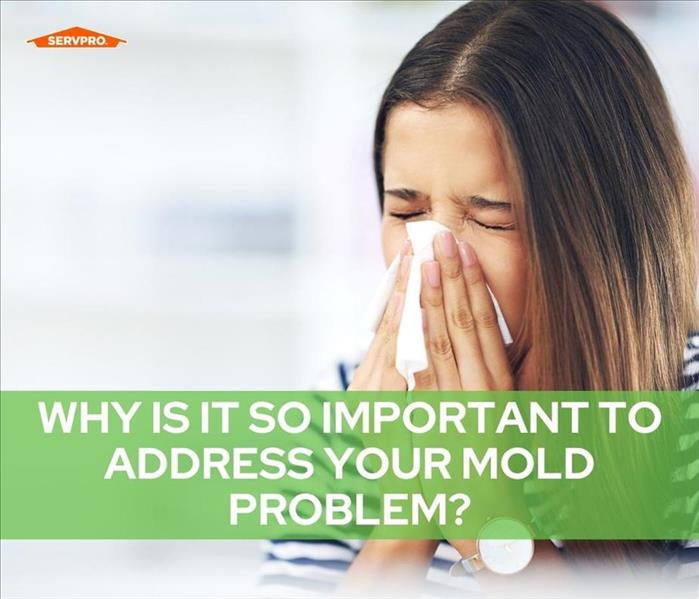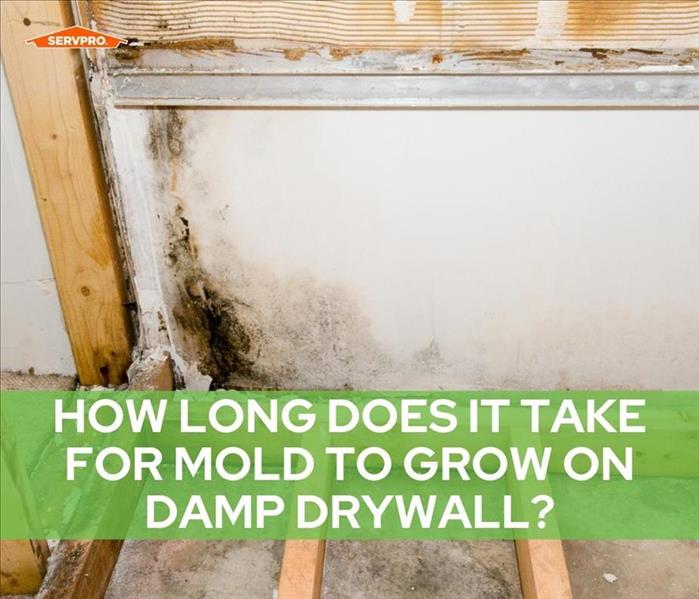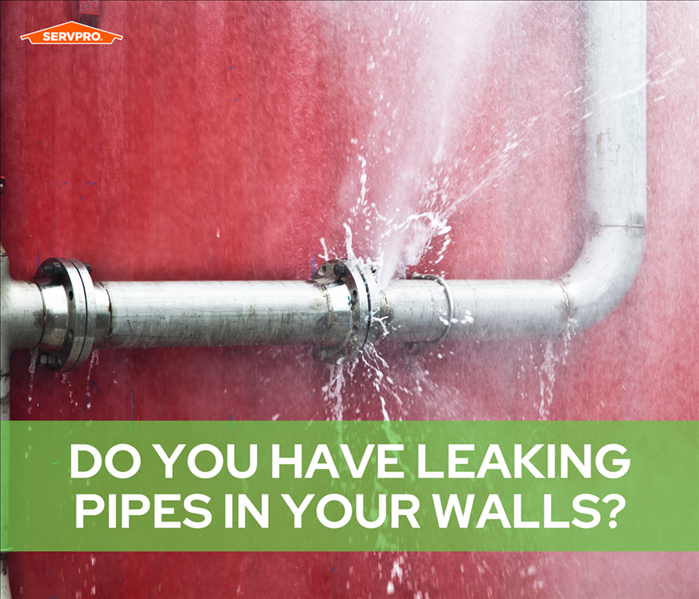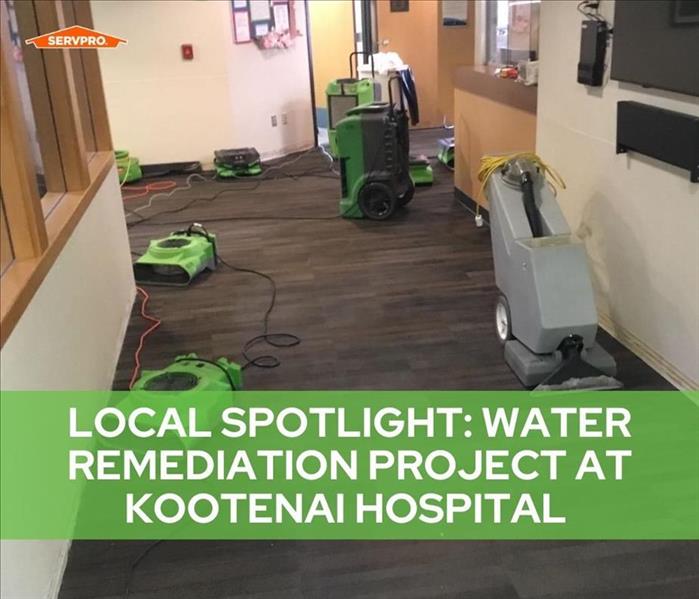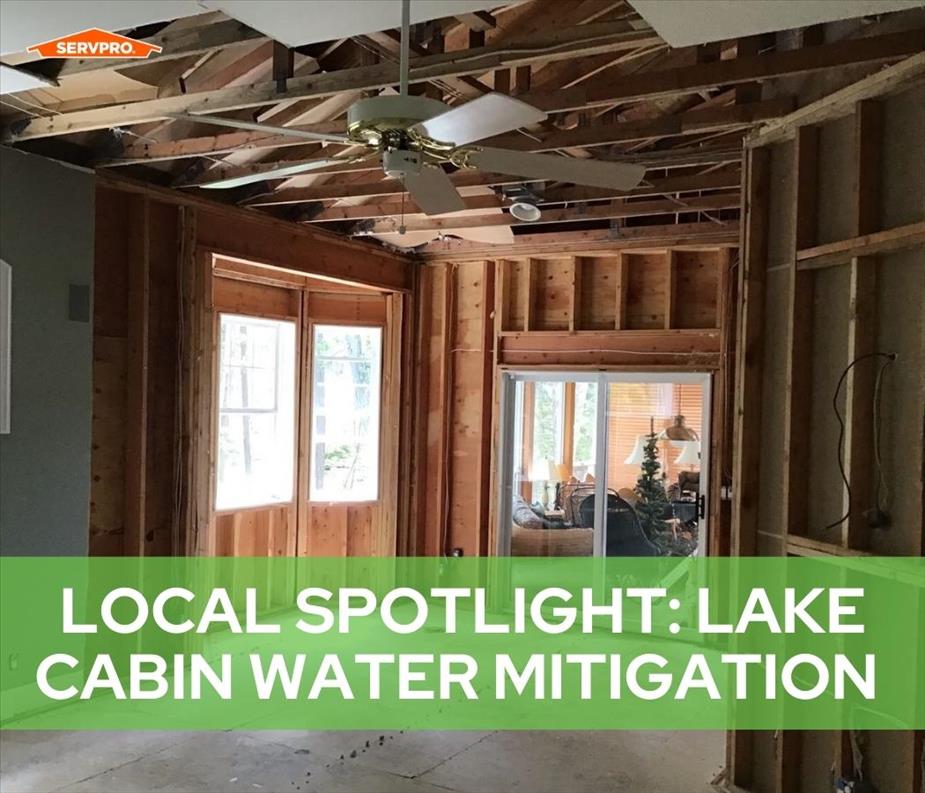Recent Blog Posts
Prepare Your Home for Storm Season: 6 Crucial Steps to Take
11/30/2023 (Permalink)
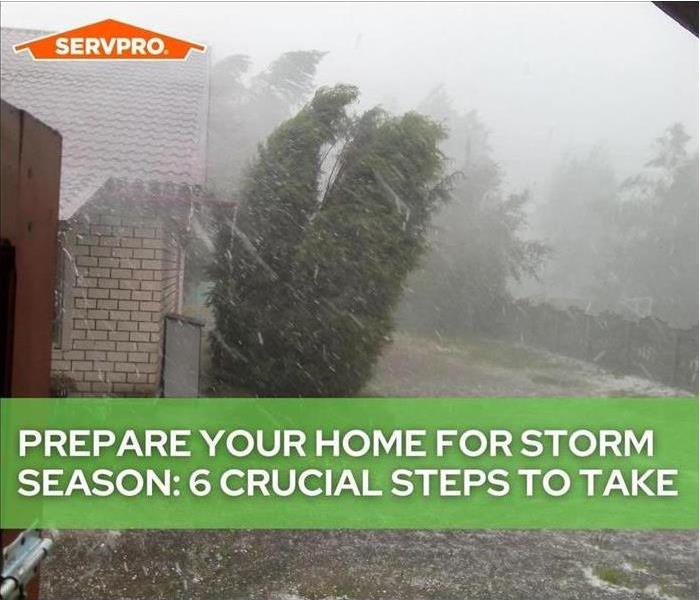 Prepare Your Home for Storm Season: 6 Crucial Steps to Take
Prepare Your Home for Storm Season: 6 Crucial Steps to Take
11/1/2022
When the winter storm season hits, anything can happen. Even the best weather professionals can get things wrong, and any of us can find ourselves Googling restoration services near me after a major storm. Thankfully, there are a few things you can do to decrease the risk that you'll experience storm damage, however.
1. Trim, Trim, Trim
Your trees are one of your home's greatest threats, and fallen trees are common after a storm. Roofs weren't made to endure blunt impacts from large trees, and the damage can be extensive. Any tree can cause some risk. Since you don’t want to cut them down, a good compromise is to trim away all dead branches and any limbs that are a threat to your home or car.
2. Repair Steps and Railings
The constant freezing and thawing of early winter, and then the ice of later winter storms, can wreak havoc on steps or railings that are already in poor condition. Fix everything up to ensure you don't have an accident.
3. Winterize Pipes and Faucets
Be sure to turn off the water to your outdoor faucets. By doing so, you can avoid having to clean up after a spring flood from a pipe that was cracked during a winter freeze. If you have indoor pipes that run close to your exterior walls, add some extra insulation or wrap the exposed pipes. Be sure to keep your home heated to at least 65 degrees to ensure pipes don't freeze.
4. Clean Your Chimney
Every year in America, nearly 27,000 chimney fires cause many millions of dollars in damage, displace families during the coldest season of the year, and even cause deaths. You take every precaution inside whenever you light a fire, but you might have forgotten about the chimney. Get your chimney inspected and cleaned every year.
5. Check the Smoke Alarms
Winter means cozy fires, heated wood stoves, electric blankets, and space heaters. These are all major fire hazards, and the simplest first line of defense for your family is a set of good smoke alarms. There are two types of smoke alarms, and you should have both.
Photoelectric alarms detect smoldering, smoky fires. They are best to have near bedrooms and places where an errant spark might settle into a rug or couch or a fire in the walls might send out smoldering heat. Ionization alarms detect fast, flaming fires, and are important to have in places where you can have a sudden, relatively smoke-less blaze, such as kitchens. You can also get dual-sensor alarms that have both technologies.
6. Prevent Ice Dams
Clogged gutters can build up ice dams that destroy the gutters and damage the roof. Clean out the gutters, and once your gutters are clean, be sure to put in quality gutter guards to keep leaves and debris from building up.
Call Us When You're Looking for "Restoration Services Near Me"
Despite the best preparations, accidents can happen. When they do, we're here for you. Contact us at SERVPRO of Coeur d'Alene right away if a winter storm damages your home.
Four Reasons To Hire a Restoration Company Instead of a General Contractor
11/30/2023 (Permalink)
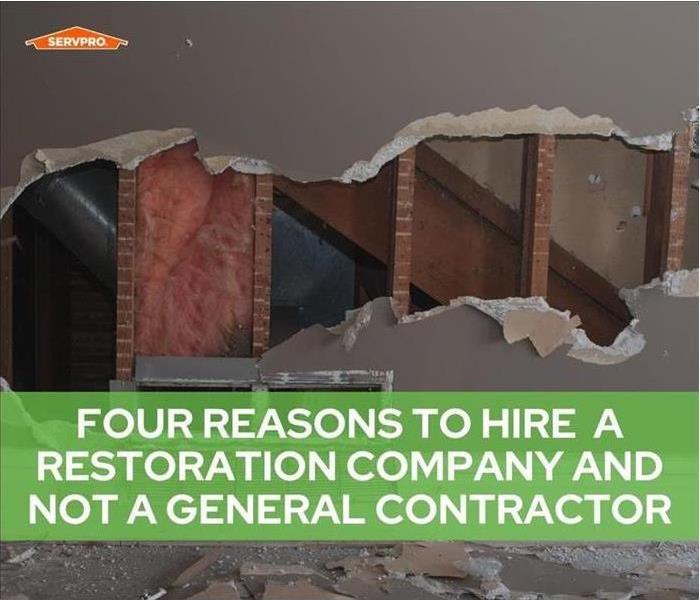 Four Reasons To Hire a Restoration Company Instead of a General Contractor
Four Reasons To Hire a Restoration Company Instead of a General Contractor
If you've experienced any kind of fire, water, storm, or mold damage to your home in northern Idaho, chances are, you are not going to opt for “do-it-yourself” no matter how much building experience you have. Instead, you need to hire a professional builder who can properly assess what needs to be done and who can restore your home to its pre-damaged condition.
But if you're thinking about hiring a general contractor to perform the work, think again. General contractors are great if you intend to remodel a house or build a new house from the ground up, but when it comes to rebuilding after a disaster, your best bet is to search for "restoration contractors near me" and, when you do, you'll find that our experts at SERVPRO are the best technicians available to handle every aspect of your restoration job from start to finish. Here’s why.
1. Specialized Skills
For starters, most general contractors outsource their jobs to subcontractors while they manage and oversee the project. They often work with the same subs, and that’s a good business practice. But when it comes to restoration, you can’t work with just any sub. Restoration work is different. It’s not just a question of building know-how, it is a question of water damage, fire damage, storm damage, and mold remediation know-how.
When you hire restoration specialists, technicians who are highly trained in specific types of damage restoration will perform all the work. At SERVPRO of Coeur d'Alene, our staff have IICRC industry certifications and undergo additional certification and franchise training. They are required to take part in continuing education classes to ensure that they know about the most up-to-date technologies and practices for repairing and restoring homes with fire, water, storm, or mold damage.
2. Thorough Service
If you hire a general contractor to perform restoration work on your home after damage, the subcontractors will certainly do their best, but the fact is, they may not have the necessary equipment to perform the cleaning, drying, or extraction processes that a professional restoration company will have. After all, their bread and butter is straight construction, and it does not make sense to purchase special equipment or provide extra training to their personnel if they rarely have to utilize that equipment or those skills.
For example, if your home has been damaged by a flood, leak, or even a fire that was extinguished by fire hoses, our experts use advanced detection devices to find water that is still present or that may have seeped into walls, attics, or floor joists in areas that look undamaged. We also have commercial drying equipment that is not available at a local big-box construction store.
Even more, for fire damage, it is not uncommon for soot and smoke to have left residue in rooms that are completely undamaged by the fire itself. That residue can create odors, cause paint or other finishes to discolor over time, and may even be toxic, leading to respiratory or other health problems. A general contractor will probably ignore those spaces that are not visibly damaged by a disaster, but a restoration company goes beyond what is visible.
3. Affordable Service
Because general contractors outsource their jobs to other trades, you end up paying not only the subcontractors’ fees, but you’ll probably end up paying a premium on that, as general contractors often charge their own fees over and above what they pay their subs. Moreover, general contractors probably won’t bother helping you with an insurance claim.
When you choose SERVPRO of Coeur d'Alene, we know what insurance companies need in order to substantiate your claim. While we can’t handle every aspect of your insurance claim, we understand that your financial well-being depends on having the insurance company cover the maximum amount of your restoration bill depending on the coverage you have. We will work with you to make sure you get the best service at the best price, with adequate documentation, to minimize any hassle or out-of-pocket costs.
4. 24-Hour Emergency Service
If your disaster occurs at night or on a weekend, chances are, you won’t be able to reach a general contractor or other conventional builder. At SERVPRO we offer 24/7 emergency services, so whether you wake up in the middle of the night to fire, water, or storm damage, you can expect an immediate response.
Contact SERVPRO of Coeur d'Alene today to learn more about the different services we offer and how we can help restore your home after a disaster.
4 Steps to Prevent Your Hose Bib From Freezing
11/20/2023 (Permalink)
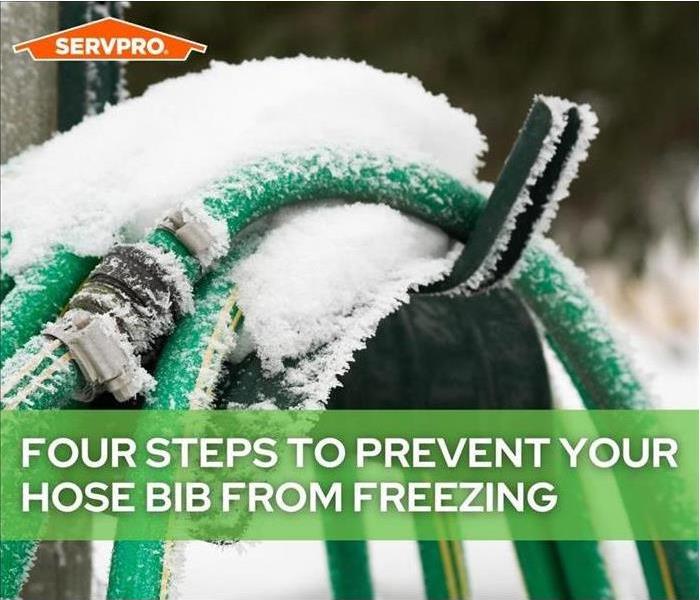 4 Steps to Prevent Your Hose Bib From Freezing
4 Steps to Prevent Your Hose Bib From Freezing
Winter is coming, and it's time to start getting prepared. Some things are unpredictable and therefore, tough to prepare for like fallen trees after a storm, but other things are in your control. As your water damage repair company, SERVPRO® can help you avoid problems during the winter such as keeping your hose bib from freezing.
Four steps to Prevent Your Hose Bib From Freezing:
1. Turn Off Water to Your Whole House
Your home has a main water pipe that supplies every faucet and pipe with running water. Find this main water pipe and turn the valve as far as it will go. Most valves should either have an on/off arrow marking to show you the correct direction or should be turned clockwise to shut them off.
2. Drain Your Outdoor Faucet
Once you've shut off the main supply of water, you want to get the remaining water out of the hose and faucet outside. Simply turn the faucet fully on, with a bucket beneath it, and allow all remaining water to flow out.
3. Turn Off Water to Your Outdoor Faucet
Locate the pipe that leads from your main water supply to the outdoor faucet or faucets. Usually, this pipe is located near the ceiling rather than near the floor, like your main valve, and should be just inside the wall from where your faucet comes out on the exterior.
If you have faucets on two or more sides of the house, make sure you get all the valves leading to each one. As with the main valve, either follow the on/off arrows or turn the valve clockwise. This will ensure that once you turn the main water supply back on, no water goes to the pipe or pipes leading outdoors.
4. Turn Your Main Water Valve Back On and Check
Keep a bucket under your outdoor faucet and, ideally, have a friend there to watch it while you turn the main water supply back on. If you did everything right, water will now flow to all other pipes but won't be coming out of the outdoor faucet/s. You should now be protected from any water damage caused by frozen pipes.
Why Is It Important to Protect Your Hose Bib?
The pipes in your house are generally protected from freezing by your home's heating system. You might have noticed, however, that smaller pipes running very close to exterior walls can freeze up on a really cold night, and the outdoor faucets are even more at risk.
They're simply too exposed, and once the water thaws again, you're liable to have extensive water damage issues because water and metal respond differently to cold. Water molecules expand as they freeze, but metal molecules retract. In other words, the pipe is getting "smaller" while the water is getting "larger," and that can break your pipes.
Reach Out to SERVPRO for Help
If you forgot to winterize your hose bib, need help figuring out what to do, or have experienced a water or storm emergency, we offer 24-hour service to protect your home and restore your structure and belongings. Remember that the longer you wait, the more you risk losing. Contact SERVPRO of Coeur d'Alene immediately if you need help.
How Long Does Water or Flood Damage Take to Dry Out?
11/1/2022 (Permalink)
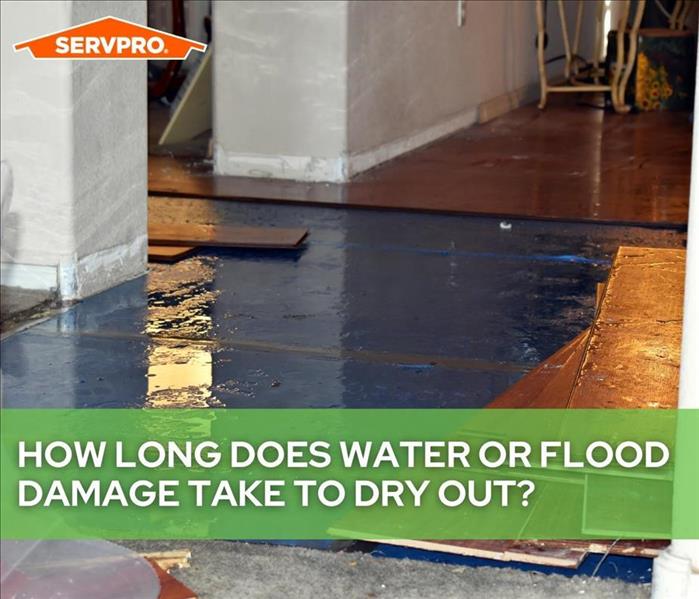 How Long Does Water or Flood Damage Take to Dry Out?
How Long Does Water or Flood Damage Take to Dry Out?
Extensive flooding in your home or commercial building can be a nightmare scenario, and even a minor leak can cause a challenging mold infestation. Water starts to damage building materials and possessions within as little as an hour, so it is important to start the water restoration process as quickly as possible. The longer areas of your home are wet, the greater the damage will be. As soon as you can, contact a quality water remediation company such as SERVPRO of Coeur d'Alene.
If you do experience a water leak or water damage, the time it takes to dry out varies according to certain factors such as:
- How many gallons of water entered your home or office building
- How long the water went unaddressed
- What types of surfaces the water contacted
SERVPRO can do a full investigation of your building in order to determine how long the water restoration process will take in your case, however, buildings can usually be restored in a few days. The average dry time for buildings with significant water damage is five days, but in some cases, only three days of drying are needed. The dry time might be as long as 7-10 days if porous flooring materials and carpeting were affected.
How Does a Water Remediation Company Address Water or Flood Damage?
Mitigating the effects of water damage and restoring your building requires a thorough process that involves correctly ascertaining the extent of the damage, removing the water, drying out lingering moisture, repairing damaged materials, and rebuilding areas that were unsalvageable. As our experts go through the following steps, they use specialized techniques and equipment to minimize the dry time:
Responding to the Call and Conducting an Assessment
Our experts are dispatched as soon as we get an emergency call. When we arrive on site, we will act fast to find the source of the leak or flooding and prevent more water from entering the building, if necessary. We will conduct tests to determine whether or not the water is contaminated, and we will perform a thorough investigation to learn how far the water has traveled.
Disposal Services and the Securing of Undamaged Items
You may have some furniture and building materials that need to be disposed of, while other possessions may simply need to be relocated and/or restored. We offer both of these services, along with the implementation of advanced sanitizing and deodorizing methods.
Water Extraction, Drying, and Dehumidifying
We use industrial-grade pumps and dehumidifiers to remove excess water and dry out the building. Sometimes, a surface may appear dry even when it is still wet, so we monitor the process carefully to ensure that all areas of your building dry out completely.
Cleaning and Restoration
Once all of the areas of the building are dry, we can focus on replacing any drywall or carpeting that was removed and conducting major repairs as needed. Sometimes, entire rooms, walls, and parts of the ceiling are rebuilt.
Questions?
Address water damage quickly to restore your peace of mind, sanitize your space, and help your building function again. When you need a remediation company that will respond with expertise at a moment's notice, contact SERVPRO of Coeur d'Alene.
5 Signs You May Have a Mold Problem
11/1/2022 (Permalink)
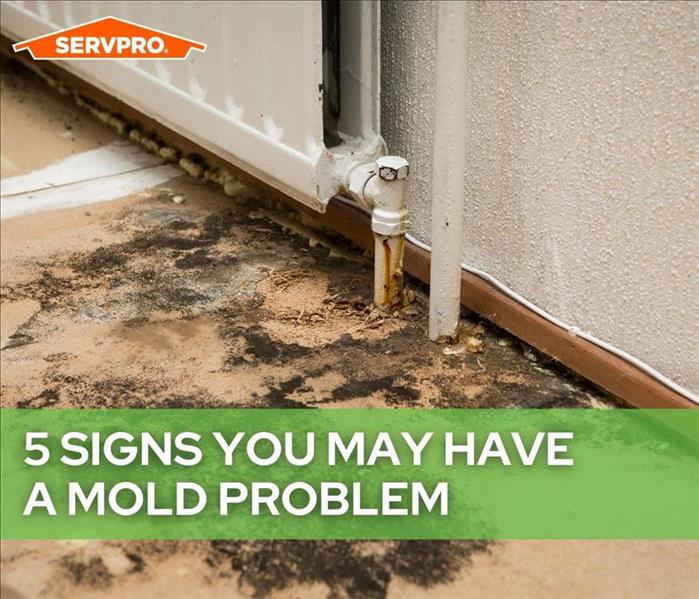 5 Signs You May Have a Mold Problem
5 Signs You May Have a Mold Problem
Every home or business owner shudders at the thought of dealing with a mold outbreak. Without the proper treatment, mold spreads rapidly and can be dangerous. Don't be caught Googling "mold removal companies near me" after the problem has escalated. Know the signs to watch for so that you can identify mold problems in their infancy and call a professional cleaning and restoration team like SERVPRO of Coeur d'Alene.
If you notice any of the following signs in your home or business give us a call and we can help you discern whether or not it's a problem.
1. Water Damage
A significant sign that you could have dangerous mold in your home is water damage. Flooding and leaks are both major contributing factors to mold growth. Often mold is caused by a water emergency that occurred before you occupied the house. Look for circular stains on the ceiling, bubbling and cracking drywall, and aged water-level stains around supporting beams in the basement or garage to discern if there was a water emergency before you arrived.
If flooding or leaking occurs while you live in the home, make sure you contact a restoration team to mitigate the damage. Having highly trained restoration specialists remove water and dry the flooded areas is the best way to prevent future mold issues.
2. Unusual Odors
Sometimes the first clue you have mold will be the accompanying smell. Unfortunately, mold damage is not always immediately visible, and the areas most severely impacted are often just out of sight. The inside of your home's walls, attics, and even HVAC system can all be infested with mold that isn't visible at a glance.
Mold has a musty, sickly-sweet odor, and the smell intensifies as you move closer to the infested area. No amount of air fresheners will consistently mask it, and it will return even after airing out the room. If you smell what you believe to be mold, call a mold remediation team and have them come to assess the situation before you try using fans to dissipate the scent. If it is mold, the last thing you want to do is potentially blow spores further through your home.
3. High Humidity Levels
High humidity levels mean a high percentage of moisture in the air. When the air is damp indoors, it creates the perfect environment for mold spores to travel and grow. In addition, condensation is more likely in areas with high humidity, and the resting moisture can contribute to mold growth.
Location plays a part in humidity levels, as does airflow. Whenever the humidity level rises above 60%, it becomes easy for mold and mildew to grow. A humidity level between 30% and 60% is optimal for most indoor environments.
4. Physical Symptoms
When mold is present in your home or workplace, you may suffer from physical symptoms. If you have a mold allergy, the Mayo Clinic has reported that you can have symptoms which include “coughing, itchy eyes, and other symptoms that make you miserable.” In addition, individuals with asthma may notice that they need to use their medications more frequently.
5. You Find Yourself Searching for "Mold Removal Companies Near Me"
If you've found yourself seeking help but haven't made the call yet, it's time to let a professional address the issue. While accepting that you may have a dangerous mold problem in your home is the last thing you want to do, the sooner you reach out for help, the sooner they can fix your mold problem.
Whether you're confident you have a mold problem or are simply questioning if you do, talking to a cleaning and restoration company is the next step you should take. Protect your health and the longevity of your home by addressing any mold issues now. Contact our team at SERVPRO of Coeur d'Alene, and let us manage your mold situation.
4 Steps to Prevent Your Hose Bib From Freezing
11/1/2022 (Permalink)
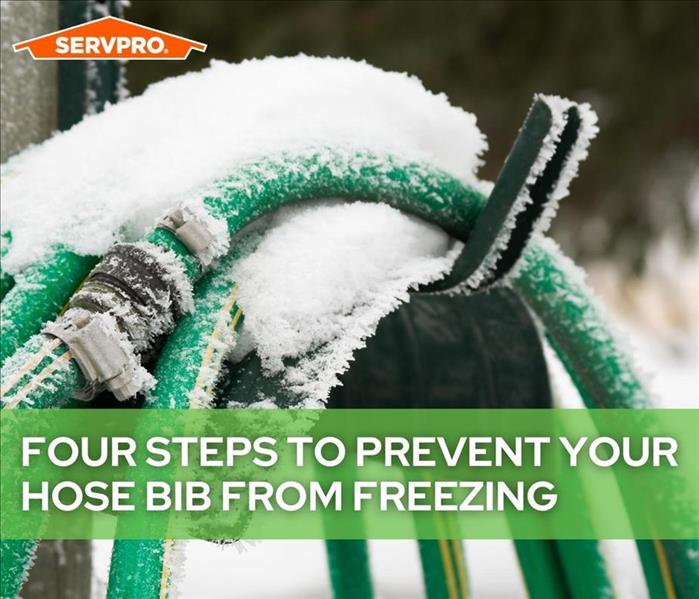 4 Steps to Prevent Your Hose Bib From Freezing
4 Steps to Prevent Your Hose Bib From Freezing
Winter is coming, and it's time to start getting prepared. Some things are unpredictable and therefore, tough to prepare for like fallen trees after a storm, but other things are in your control. As your water damage repair company, SERVPRO can help you avoid problems during the winter such as keeping your hose bib from freezing.
Four steps to Prevent Your Hose Bib From Freezing:
1. Turn Off Water to Your Whole House
Your home has a main water pipe that supplies every faucet and pipe with running water. Find this main water pipe and turn the valve as far as it will go. Most valves should either have an on/off arrow marking to show you the correct direction or should be turned clockwise to shut them off.
2. Drain Your Outdoor Faucet
Once you've shut off the main supply of water, you want to get the remaining water out of the hose and faucet outside. Simply turn the faucet fully on, with a bucket beneath it, and allow all remaining water to flow out.
3. Turn Off Water to Your Outdoor Faucet
Locate the pipe that leads from your main water supply to the outdoor faucet or faucets. Usually, this pipe is located near the ceiling rather than near the floor, like your main valve, and should be just inside the wall from where your faucet comes out on the exterior.
If you have faucets on two or more sides of the house, make sure you get all the valves leading to each one. As with the main valve, either follow the on/off arrows or turn the valve clockwise. This will ensure that once you turn the main water supply back on, no water goes to the pipe or pipes leading outdoors.
4. Turn Your Main Water Valve Back On and Check
Keep a bucket under your outdoor faucet and, ideally, have a friend there to watch it while you turn the main water supply back on. If you did everything right, water will now flow to all other pipes but won't be coming out of the outdoor faucet/s. You should now be protected from any water damage caused by frozen pipes.
Why Is It Important to Protect Your Hose Bib?
The pipes in your house are generally protected from freezing by your home's heating system. You might have noticed, however, that smaller pipes running very close to exterior walls can freeze up on a really cold night, and the outdoor faucets are even more at risk.
They're simply too exposed, and once the water thaws again, you're liable to have extensive water damage issues because water and metal respond differently to cold. Water molecules expand as they freeze, but metal molecules retract. In other words, the pipe is getting "smaller" while the water is getting "larger," and that can break your pipes.
Reach Out to SERVPRO for Help
If you forgot to winterize your hose bib, need help figuring out what to do, or have experienced a water or storm emergency, we offer 24-hour service to protect your home and restore your structure and belongings. Remember that the longer you wait, the more you risk losing. Contact SERVPRO of Coeur d'Alene immediately if you need help.
How Long Does Mold Removal Take?
11/1/2022 (Permalink)
 How Long Does Mold Removal Take?
How Long Does Mold Removal Take?
Discovering mold in your home or business can be extremely alarming. Everything from health and safety concerns to expense and time worries crowds your mind. You are probably asking yourself a lot of questions such as, are there any companies that provide mold remediation services near me? And how long will it take to get this mold taken care of so I can get back into my house or business?
The answer to the first question is easy: Yes! SERVPRO of Coeur d’Alene has experience remediating all sorts of building disasters, including mold infestation. The second question, however, is a little more complicated to answer, because each scenario is different, with different levels of severity when it comes to mold. But a good ballpark answer is: usually, the mold remediation process lasts between one and five days. Why so long? Well, there is a lot more involved in mold clean-up than spraying and wiping.
What Causes Mold to Grow?
Mold spores are everywhere, on surfaces, in the air, inside, and outside. They are microscopic and can float into your house on a breeze or come running in on your dog’s fur, and your HVAC system can blow mold spores all over your house. You cannot completely eliminate mold from the air or your house, so the goal is not to eliminate all mold, but to not let mold colonies develop and take hold.
A mold colony can develop in as little as 24-48 hours once spores are introduced to moisture. As the spores enter your home, they will cling to high-humidity areas. The most common sources of mold colony growth are:
- Leaking Pipes
- Areas with high levels of humidity (think: bathrooms, kitchens, and laundry rooms);
- Lack of or inadequate ventilation
- Condensation
- A leaking roof or ceiling
- A damp basement or crawl space
- Recent home flooding or storm damage
Signs Mold Is Present
Sometimes mold grows in visible areas making it easy to spot: a dark or black splotch or spots on the wall. Other times, it lives inside your walls, spreading quickly. While only a trained specialist can conclusively identify mold, there are tell-tale signs to look for if you suspect mold in your home or business:
- Musty odors
- Unexplained spots on carpeting
- Peeling or bubbling wallpaper
- Persistent allergy symptoms or other unexplained health problems
- Dark or colored spots on walls
- Warped wood or drywall
If you suspect mold, don't disturb the area. Mold spores can easily spread through the air where you may breathe them in, or where they can easily migrate to other parts of your home or business.
The Remediation Process
Once you spot or suspect mold in your building, call a professional right away. They will identify the trouble areas and go over a mold remediation plan with you. Steps in this remediation plan will likely include:
- An inspection and damage assessment: this will include a thorough visual search, as well as using various technologies that can detect mold and hidden moisture;
- Containment: it is critical to keep the mold contained in one area, and there are various ways of preventing the spread of mold spores.
- Air filtration: in the contained area, “air scrubbers” that will filter spores out of the air are set up.
- Removing mold and infested materials: the area will be thoroughly cleaned with antifungal and antimicrobial cleaning agents; some mold infestations will require the removal of severely infested articles, such as drywall or carpeting.
- Cleaning belongings and surrounding surfaces: while hard surfaces are relatively easy to clean, furniture and other belongings may need to be disinfected in other ways, and deodorized by fogging.
- Restoration: we will restore the area to the way it was before the damage occurred.
Get Professional Help Immediately
Once you suspect mold, finding the right company to tackle the problem is critical. Don’t try to resolve the problem yourself: when it comes to mold, going the DIY route may end up making the situation worse. The longer you wait, the more complex the remediation and restoration process becomes.
Get your mold problem solved quickly and thoroughly. At SERVPRO of Coeur d'Alene, we're pleased to be the trusted leader in clean-up and restoration in our community. If you spot or suspect mold in your home or business, contact SERVPRO of Coeur d'Alene today—we're close by and ready to respond!
Prepare Your Home for Storm Season: 6 Crucial Steps to Take
11/1/2022 (Permalink)
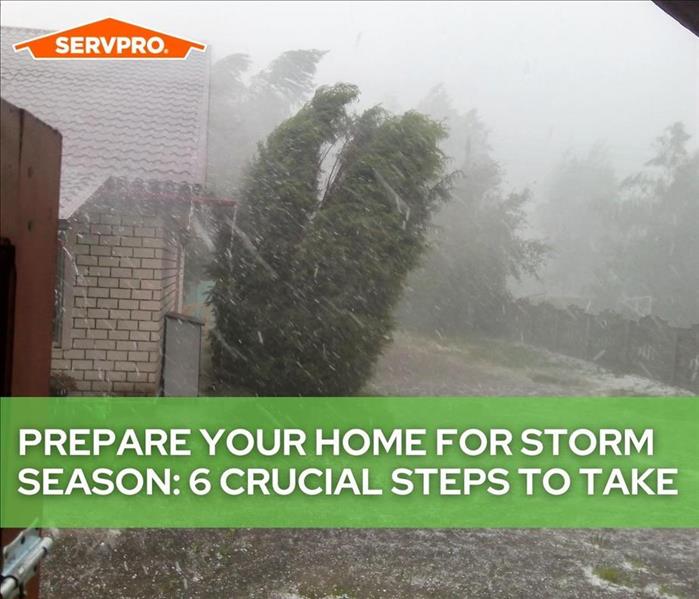 Prepare Your Home for Storm Season: 6 Crucial Steps to Take
Prepare Your Home for Storm Season: 6 Crucial Steps to Take
When the winter storm season hits, anything can happen. Even the best weather professionals can get things wrong, and any of us can find ourselves Googling restoration services near me after a major storm. Thankfully, there are a few things you can do to decrease the risk that you'll experience storm damage, however.
1. Trim, Trim, Trim
Your trees are one of your home's greatest threats, and fallen trees are common after a storm. Roofs weren't made to endure blunt impacts from large trees, and the damage can be extensive. Any tree can cause some risk. Since you don’t want to cut them down, a good compromise is to trim away all dead branches and any limbs that are a threat to your home or car.
2. Repair Steps and Railings
The constant freezing and thawing of early winter, and then the ice of later winter storms, can wreak havoc on steps or railings that are already in poor condition. Fix everything up to ensure you don't have an accident.
3. Winterize Pipes and Faucets
Be sure to turn off the water to your outdoor faucets. By doing so, you can avoid having to clean up after a spring flood from a pipe that was cracked during a winter freeze. If you have indoor pipes that run close to your exterior walls, add some extra insulation or wrap the exposed pipes. Be sure to keep your home heated to at least 65 degrees to ensure pipes don't freeze.
4. Clean Your Chimney
Every year in America, nearly 27,000 chimney fires cause many millions of dollars in damage, displace families during the coldest season of the year, and even cause deaths. You take every precaution inside whenever you light a fire, but you might have forgotten about the chimney. Get your chimney inspected and cleaned every year.
5. Check the Smoke Alarms
Winter means cozy fires, heated wood stoves, electric blankets, and space heaters. These are all major fire hazards, and the simplest first line of defense for your family is a set of good smoke alarms. There are two types of smoke alarms, and you should have both.
Photoelectric alarms detect smoldering, smoky fires. They are best to have near bedrooms and places where an errant spark might settle into a rug or couch or a fire in the walls might send out smoldering heat. Ionization alarms detect fast, flaming fires, and are important to have in places where you can have a sudden, relatively smoke-less blaze, such as kitchens. You can also get dual-sensor alarms that have both technologies.
6. Prevent Ice Dams
Clogged gutters can build up ice dams that destroy the gutters and damage the roof. Clean out the gutters, and once your gutters are clean, be sure to put in quality gutter guards to keep leaves and debris from building up.
Call Us When You're Looking for "Restoration Services Near Me"
Despite the best preparations, accidents can happen. When they do, we're here for you. Contact us at SERVPRO of Coeur d'Alene right away if a winter storm damages your home.
At What Speed Does Wind Start to Cause Damage?
8/22/2022 (Permalink)
When you live in an area that experiences periodic windstorms, it is helpful to be aware of the potential risks of what these storms can do. While the inland Pacific Northwest is not subject to the hurricane-force winds that occasionally hit places like Florida, it has been known to have its share of high-wind storms that have knocked down trees, blown off roof tiles, and downed power lines, causing power outages for residents that have lasted weeks.
Residents in northern Idaho should know what can occur in severe wind events, and should take some steps to prepare, especially as fall arrives. Knowing the harms that can be caused by various wind speeds enables you to predict the likelihood of facing damage to your house or property. When you see a weather forecast or get a warning from the local utility companies that high winds are expected, take some steps to prepare your property, and know that SERVPRO of Coeur d’Alene is ready to step in and help if you need restoration work done.
Wind Speed and Associated Damage
0-25 mph: Winds in this range can feel pretty brisk, but rarely cause damage. If winds are a steady 10 mph, you can tell the kids to put a jacket on and get out their kites. But as they climb to the upper limits of this range, you can expect leaves to come off your trees, and you might want to take in your outdoor seat cushions or any other loose and light items off the porch or deck and stow them away so that you don’t have to hunt for them on the neighboring property when it’s all over.
25-50 mph: At this speed, it isn't unusual to lose a few shingles off the roof, especially when there are stronger gusts. Houses with aging roofs will, of course, be at greater risk for damage, and if you have a building that is not structurally sound, such as an old barn, you might see some destruction.
50-75 mph: At this speed, winds can be seriously damaging. Losing your roof shingles is common, and anything that is unsecured is likely to blow or tear off – including branches on dead or dying trees. If the ground has softened from rain, you can expect some trees to come down, especially if they have lots of branches and leaves or pine needles that will catch wind.
75-100 mph: With winds at this speed, even healthy trees can be uprooted. Mobile homes, trailers, and sheds can be destroyed, and even large moveable objects can become airborne, flying into cars and buildings.
Over 100mph: If you are facing winds like this, hopefully, you have evacuated the area. Even solid, newly-built homes will experience significant damage. This is category 2 hurricane-force wind, which can flip cars and blow out windows.
In the Coeur d’Alene-Spokane region, a wind storm that reaches 50 mph is not that uncommon in a storm season, and it can be accompanied by gusts that exceed 70 mph. To complicate matters, these storms may be accompanied by rain, snow, or ice, which can cause ice build-up on trees, roofs, and gutters, making them very heavy, and subject to collapse.
Protecting Your Home From Wind Damage
While there's nothing you can do to prevent bad weather, you can take proactive actions to help your home fare better in a storm by having a plan in place whenever a storm is a forecast. Here are some important items that should be part of your plan.
Declutter Your Yard: As the weather cools down, start putting away the items that you won’t be using, such as lounge cushions, decorations, lanterns, umbrella shades, shade sails, and so on. Even hoses and garden tools should be stowed for the season so that you don’t have to worry about them getting damaged from rain and ice. Take down the wasp traps, and hanging plants. Any easily moveable object is subject to get either blown away or may become a projectile if winds pick it up. Furniture, too, should be secured or stowed, so it doesn’t get knocked over and damaged.
Maintain Your Home: Check your roof to see if it needs repairs, and check other items on your roof: skylights, vents, chimneys. If they need repairs, do them before the storm season hits, or you may be looking at doing more extensive repairs later–and doing them in cold, unpleasant weather. Check your windows, outdoor light fixtures, and door seals.
Check the Area Around Your House: Take a good look at the area around your home and property. Are any trees liable to hit your house if they fall down? Are there heavy, low branches that should be pruned? Are any of the trees dead or dying? Are the power lines and power poles clear? A few prudent steps now can save you from disaster.
Storm Restoration Companies Should be Available 24/7
Sometimes, even when you prepare well, you can still suffer from a natural disaster. If you suffer any storm damage, know that our team at SERVPRO is ready to help. We serve our community around the clock and arrive faster to any disaster, no matter what time of day. When disaster hits, put our number on speed-dial to contact SERVPRO and receive the professional help you need.
What Are the Risks of Ignoring Water Damage?
8/22/2022 (Permalink)
When you think of water, you probably think of its beneficial properties: keeping you hydrated, helping plants flourish, washing away dirt, and clearing the air. But water is also one of the most destructive forces in nature: wearing away cliffs, flooding cities, and towns, and washing out highways. The fact is, water is a very powerful force, and that is why we do our best to control it by channeling it into culverts, drains, canals, pipes, and gutters.
But what happens if all the things we do to keep water out of our buildings fail? Maybe you have a gap in your roof’s flashing, a leaking drain pipe, or a gap in your window header. Or maybe just too much moisture from the clothes dryer or shower is leaving condensation in your attic. The fact is, we use a lot of water in our homes and in our businesses, and even small water problems, if not resolved as soon as they are discovered, can lead to big damage.
The longer water damage goes unaddressed, the more damage it will do in your home or commercial building. That’s because the damage is not always just the water itself–although that, too, can be serious. Water can weaken and rot wood and drywall, destabilize the ground, and create the ideal environment for mold, mildew, and bacteria.
When you discover water damage, It can be tempting to put off addressing it, especially if it is in a space like your attic, basement, or crawlspace, where it is not impacting you everyday and because you do not want to shoulder the cost of repair. But you should always treat water damage as an emergency, and call an expert in water damage restoration as soon as possible.
Health Hazards Caused by Unaddressed Water Damage
One of the biggest risks of not remediating water damage is that dampness encourages the growth of mold and mildew. Mold, in particular, grows and spreads quickly, and not just in the sense of the unsightly green, black, or even pink muck found on surfaces. Mold spores are tiny, and can spread throughout your house with just a whiff of air, and get into your furniture, your air ducts, your bedding, and so on. And once the mold spores spread to these places, it is very difficult to eradicate them.
According to the Mayo Clinic, some people have allergic reactions to mold. If they are especially sensitive, they may experience symptoms similar to hay fever: itchy eyes, sneezing, congestion, or even itchy skin when spores come in contact with the skin. For people with asthma, mold can sometimes trigger an asthmatic attack.
Structural Damage
Water has an uncanny ability to get nearly everywhere. While it always flows down, it does not always flow the way you might expect unless it is carefully channeled, which is why we use channels, gutters, and pipes whenever we use water. But if it escapes the conduits specifically designed to contain it, it will seep into places we cannot reach, including down into the foundations of our houses.
Once under the house, water can cause tremendous damage. By softening the ground underneath the foundation, it will cause the foundation structure, bearing all the weight of the house, to sag, and cause cracks in concrete, brick, and wooden beams and joists, compromising the integrity of the entire structure: floors, walls, ceiling, and roof. Trying to save your house by rebuilding the foundation is not a restoration project you want. As soon as you know that water is not where it should be, call in a professional to get it back under control.
Unsightly Stains and Foul Odors
In addition to the health impacts, mold, mildew, water stains, and buckled baseboards or flooring are unsightly, and can often emit an unpleasant odor that is hard to get rid of. If you are noticing a strong, musty odor in your building, or you see discoloration in your paint, it may be the first sign of a problem caused by water damage. If left too long, odors can permeate everything, from furniture to drapes, to bedding, and even your clothing.
High Water Bills
If you have a leak that is unseen, you may notice that your water bill is unusually high (or even that your heating bill is high, if the leak is at your water heater). If you see your utility bills take a bad turn and cannot understand why, leaking water may be the culprit. So one benefit of having your water problem addressed is that you can stop a problem that may be costing you money every month.
Electrical Issues
Water damage and electricity should never mix. So if you have a water leak, you also have to worry about your electrical. If water seeps into electrical wiring or components, you may be in store for an even bigger problem, causing shorts, power outages, or even shocks and sparks that can ignite a fire. If you know that a water leak has caused an electrical problem, don’t use any electricity; completely shut down the power from your central panel and have a professional come in and assess the damage.
Water Damage Restoration Companies in Coeur d’Alene
If you live in North Idaho, help is not far away. You can avoid the negative consequences of leaving a water problem unsolved by contacting our experts at SERVPRO of Coeur d’Alene. We service all communities surrounding our Coeur d'Alene location.
When leaks or flooding occur in a home or a commercial building, the damage can be minimized with a fast response time. As soon as we receive your call, we will get to work assessing the damage, stopping the problem at its source, drying out the area, caring for your belongings, and restoring your home. If you are in need of water damage restoration or mold remediation, contact SERVPRO of Coeur d'Alene right away.
Local Spotlight: Coeur d’Alene Regional Chamber of Commerce
8/22/2022 (Permalink)
You might not think of lovely Coeur d’Alene as a place where you would get much flooding damage, but at SERVPRO of Coeur d’Alene, we actually see our fair share. A lot of homes and buildings in northern Idaho have basements, and, since water always flows down, whenever there is water damage, a basement or crawl space is the likely site. Keeping an eye out for water damage in these spaces is an important part of the home and building maintenance.
Frequently, the types of water damage problems we handle are from things like leaking or burst pipes, activated fire sprinklers, or faulty appliances. But another source of water damage in the Pacific Northwest is from storms, and when Coeur d’Alene is hit with a storm, some of them can surely dump a lot of rain! This was the case with a storm that hit Coeur d’Alene earlier this year.
During a storm with lots of rain and high winds, the storm door in the basement of the Coeur d’Alene Chamber of Commerce could not hold all the water out, and started flooding the carpet, stairs, and the basement, which was used primarily for storage. The employees piled up sandbags, but they just were not keeping the water out. That’s when they made the prudent move and called the professionals at SERVPRO.
SERVPRO of Coeur d’Alene prides itself on responding quickly when a customer needs us. Not only do we know that our quick response can provide real, practical help, but it also gives our customers tremendous peace of mind. Sometimes a problem, such as flooding, is just too difficult to tackle yourself, especially when you don’t have the manpower, the know-how, or the equipment to do the job. For the Chamber of Commerce, we were able to have our personnel and the right equipment on-site within three hours.
The first order of business was to stop the problem, and we were able to add more sandbags and stem the water flow. Then, it was a question of identifying the extent of the damage and cleaning up the water. SERVPRO got to work setting up pumps, dryers, fans, and dehumidifiers, and making a careful inspection of the site.
Thankfully, because the Chamber acted so quickly, we realized that simply drying everything out would take care of most of the damage. SERVPRO pulled off the rubber baseboard to inspect for additional damage and to help the dryers be more effective. Keeping the dryers and dehumidifiers going, and testing periodically, we were able to get the entire space dried out over the course of a few days. The only reconstruction required was to reapply the rubber baseboards. From beginning to end, the entire process of getting them back to full operational order was about 12 days.
Happy – and relieved – customers is our goal and the Chamber of Commerce let us know that we scored a “perfect 10” on helping them address and recover from their storm damage.
If you have water damage, or experience any other kind of disaster–fire, storm, flooding, mold – contact the professionals at SERVPRO, any time of day or night. We can tackle any size problem, from minor damage all the way to complete building reconstruction. SERVPRO of Coeur d’Alene is proud to serve the communities throughout Kootenai County including Post Falls, Rathdrum, and Sandpoint. We’ll be here when you need us.
What's the Difference Between Mold Removal and Mold Remediation?
8/22/2022 (Permalink)
If you are unsure about the difference between mold removal and mold remediation, you aren't alone. Because the two terms are often used interchangeably, many individuals are confused about the difference, and may not realize that one might be better than another in solving their mold issue. Here's what you need to know about both processes and how to determine if it's time to call a mold remediation specialist.
Something many people don't realize is that complete mold removal isn't possible in most residential and commercial environments. Mold spores are everywhere, indoors and outdoors. They are microscopic, and they drift through the air. So mold removal companies cannot really remove all the mold, they only clean up visible mold, not the spores.
Mold remediation, however, is more than just the removal of visible mold. Mold remediation eliminates current mold growth and minimizes the potential for future growth in your space. Instead of cleaning only the visible mold, remediation takes a "big-picture" look at your mold problem to find the best solution to eliminate the current mold problem, prevent future mold growth at the site, and limit the release of spores during the cleaning process so that the mold will not easily spread.
The Remediation Process
Although each mold problem requires individualized treatment, most mold remediations follow the same general procedure. At SERVPRO, we have proven methods of mold cleaning and containment that we adapt to fit the needs of your unique situation.
Step 1: Call a SERVPRO Mold Remediation Specialist
The first step in addressing any mold issue is calling for help. Since mold releases spores into the air when disturbed, you don't want to DIY mold cleanup. When you call our emergency hotline, a SERVPRO team member will ask you questions about your mold problem so that we can arrive prepared to address your issue.
Step 2: Mold Inspection and Assessment
Determining the scale of your mold problem is essential to addressing it appropriately. Once we arrive at your home or business, a remediation specialist will evaluate the extent of the damage, the type of mold present, and the moisture source that is feeding its growth. This inspection goes beyond simply looking for visible mold. Our professionals use cutting-edge technology to find concealed moisture issues and gauge the amount of spores present.
Because mold can present a serious health hazard, there are laws regarding the proper inspection and handling protocol based on the affected area's size. Our team will inform you if your situation requires additional inspection or documentation.
Step 3: Containment
Preventing spores from traveling to other areas of your home or workplace is a top priority during the remediation process. Equipment such as negative air chambers and physical barriers will be utilized throughout the cleaning to prevent the spread of spores. In addition, you will have to turn off any HVAC units in the affected area, so that air does not flow through ducts to other parts of the building.
Step 4: Air Filtration
Since mold releases spores when disturbed, removing mold without air filtration is ill-advised. Services that only remove visible mold may clean up the mold you can see but can compromise your family's or staff’s health by triggering the release of millions of spores. Consequently, the next step is to run HEPA filtration equipment that pulls microscopic spores from the air throughout the process.
Step 5: Mold Elimination
The best mold cleaning method will be determined by the material that has been affected. Some materials may need to be disposed of if they cannot be restored. For example, porous materials such as carpet and drywall are virtually impossible to clean thoroughly. Items that can be cleaned will be cleaned thoroughly and treated with antimicrobial solutions to prevent future growth.
Step 6: Disinfection and Odor Removal
Once your mold issue has been addressed, the last thing you want is a musty odor to remind you of the problem. Our professionals will use fogging equipment to deodorize the space. They will also clean and disinfect other items exposed to the mold.
Step 7: Restoration
Sometimes the mold remediation process will require the removal of structural elements, such as paneling, drywall, flooring, and subflooring. So the final step in remediation is rebuilding and restoring the areas affected by the remediation process to their previous condition – but this time, without the mold.
If you see mold or smell a musty odor in spaces of your home or business, it is important to address the issue quickly. But do not try to handle the problem alone without the know-how and proper equipment. Since mold problems will not resolve themselves, contact a professional mold remediation team at the first sign of trouble. Call SERVPRO of Coeur d'Alene today.
Why is it So Important to Address Your Mold Problem?
8/22/2022 (Permalink)
If you've found visible mold anywhere in your home or office space, or if you keep noticing musty odors, chances are you’re concerned about whether you have a serious mold problem. The first thing you should know is that any noticeable mold should be treated as a serious problem.
While visible mold may only be present in one or two places, mold is actually everywhere. Microscopic mold spores float through the air, and can spread extensively throughout a residence or an office in as little as 48 hours through the HVAC system. Fortunately, advanced remediation techniques can control the level of mold in your building and restore the cleanliness of your space – but the problem can become harder to resolve the longer it is left untreated.
No matter how much cleaning you do, there will always be at least some mold spores present, both inside and outside your home or business. It is when the spores come into contact with excessive moisture or cellulose that the mold can grow out of control, and you notice black spots or blotches on a wall or surface. Many types of mold can affect your home, including toxic “black mold.” Because mold is a health hazard that can affect the livability and value of your property, it is important to contain and remediate it as soon as possible.
What Types of Problems Does Mold Cause?
Visible mold is definitely unsightly, and no one likes to find moldy bread or cheese in the refrigerator or moldy oranges in the fruit bowl, so we throw those things out. But other than avoiding it when we see it, why is it bad? After all, penicillin, a beneficial drug, is made from mold. The blue part of blue cheese is mold – and we actually eat that.
There are many different types of mold, and not only is much of it beneficial, it is actually necessary: molds help decompose dead material. But many people can have adverse health problems from too much mold, and, in particular, breathing in the mold spores that float through the air. So the problem is not necessarily mold per se, but the degree to which an area is infested with mold, and the type of mold you are dealing with.
As noted above, mold spores are tiny, even smaller than particles of pollen. And just as some people have allergic reactions to pollen, people can have allergic reactions to mold. According to the U.S. EPA, allergies to mold are fairly common. Inhalation of the spores can cause respiratory symptoms similar to hay fever, such as sneezing, itching, watery eyes, and wheezing, and some people can develop a rash from contact. For people with asthma, mold spores may trigger an asthma attack.
If Mold is Everywhere, How Can I Avoid These Health Problems?
You are likely to find visible mold in parts of your building that are damp, as dampness provides the ideal environment where mold likes to colonize. If you find mold or smell something that is “not right,” give SERVPRO a call.
Keep in mind that, while you cannot entirely eliminate all mold, you can restore safe mold levels in your building through mold remediation. Be wary of companies that promise “mold removal,” because it may mean that all they really do is clean up visible mold, without doing enough to contain the further spread of mold or prevent future growth, which is critical to minimize adverse health effects.
As soon as you call us, we will ask some questions to determine what equipment we think we will need to bring. When our experts come to your building, they will do a thorough inspection to locate all the problem areas – not merely where you see or suspect mold growth. Once we identify the problem areas, we will begin the remediation process.
During mold remediation, we seal off the area or areas that need to be treated. We will ask you to shut down or seal off your HVAC system in that area. We use negative air chambers to isolate the air in that area, and set up an air filtration system that incorporates HEPA vacuums and “air scrubbers” to filter out any spores in the air. We clean all the surfaces with antifungal and antimicrobial cleansers. If there are infested materials, they are removed and discarded.
Finally, we will rebuild and repair the parts of your structure that need restoration. We will clean and treat any items that are in the area that do not need to be discarded. By the time the process is over, your home or commercial building will feel like it's back to normal.
Find a Remediation Company Near Me
Our mold remediation experts at SERVPRO of Coeur d’Alene can be quickly dispatched to tackle mold problems in Coeur d’Alene, Bonners Ferry, Sandpoint, and surrounding communities.
Fast response times and thorough remediation techniques are the key to getting a mold problem under control. If you suspect mold, contact SERVPRO of Coeur d'Alene today.
How Long Does It Take for Mold to Grow on Wet Drywall?
8/22/2022 (Permalink)
If you've ever had the misfortune of having a water pipe break or your roof leak, you know the dread that occurs when you watch water seep into your home's drywall. If your first instinct is to search online for "water damage restoration contractors near me," that's a wise move. Not only can your drywall be physically damaged by the water itself, but the dampness and darkness also create the perfect environment for mold to run amok.
Most types of mold can experience significant growth in the first 24-48 hours following water intrusion. However, since mold spores are naturally present nearly everywhere, you shouldn't wait to see if mold develops before seeking help. Mold growth is almost always a given following water intrusion, even if it isn't in an easily visible area. Since hidden mold can contribute to a variety of health problems, don't put off calling a professional restoration crew.
Factors That Influence Mold Growth
Your Home’s Temperature: Mold spores can reproduce and grow more quickly in a warm environment. That's why mold growth increases during the summer months. If your home has been impacted by water damage, dropping the temperature might buy you precious time to dry out the area before mold spores develop. Since it's easier to address the problem before mold establishes new growth, you'll want to do everything possible to make your home inhospitable to mold.
Organic Surfaces: Organic surfaces are a source of food for growing mold spores. If you have an organic surface, like many painted walls, mold will spread quickly throughout the room. The fewer organic materials you have in the area, the slower mold will spread. If you are concerned about the potential for mold or have areas in your home prone to moisture problems, such as laundry, bathroom, or kitchen, where water and steam are present, selecting an inorganic wall paint can help minimize mold's ability to spread throughout your living space.
Ventilation: Mold thrives in damp places like crawlspaces and basements. The main reason is that these areas typically suffer from poor ventilation, darkness, and moisture. When airflow is limited, it becomes easier for humidity levels to rise and for mold growth to explode. Conversely, maintaining airflow can dry out a damp space and make it more challenging for spores to get the moisture they need to grow.
Move Fast to Prevent Disaster
While you may be tempted to see if flooding or water damage dries out on its own, the time you wait before calling a restoration service allows mold growth to begin. Drywall is especially vulnerable to mold growth, and mold spores will multiply rapidly and exponentially if the moisture isn't addressed immediately. Remember, just because mold isn't visible doesn't mean it isn't there.
While mold colonies can form within 48 hours of water damage, the growths may not become visible for a few weeks. Unfortunately, the lack of visible mold often gives homeowners a misguided sense of relief. If you have water damage on drywall, you will have a mold problem unless the surface is completely dried out within 48 hours of being wet.
Don't Wait for Trouble: Be Prepared
The best time to plan for what you'll do if a leak or flood damages your home is before the situation occurs. Keep the SERVPRO 24-hour emergency hotline number on your fridge or stored in your phone for emergencies. If you need emergency service, call (208) 457-1234 anytime to connect with one of our skilled representatives. They will collect information about your situation and dispatch a team to help you.
Don't let water intrusion leave you with out-of-control mold growth. Contact SERVPRO of Coeur d'Alene today and let our team restore your home.
Finding Water Restoration Companies Near Me: Do You Have Leaking Pipes in Your Walls?
8/16/2022 (Permalink)
If you find out that the pipes in your walls are leaking, it’s highly likely that you have incurred some damage to your home or business that requires professional restoration. If you find yourself searching for "water damage restoration companies near me" you will find that our experts at SERVPRO are top-rated for water damage repair and restoration. Whatever the damage, and however it has affected your building, you can count on our experts to resolve every issue.
Signs of Water Damage
Of course, the most obvious sign of a leaking pipe is water dripping and puddling inside of your building. But that is not the only thing that you should watch out for. Any wet areas that cannot be explained by a recent spill or other accident could be a sign that there is a leak.
If a leak is slow, it may take a while for any damage to show up. You may start to notice discoloration of your ceiling or walls, or a water stain may start to appear and grow larger. Another sign might be baseboards expanding or warping, or your floorboards beginning to buckle.
In some cases, it may not be something you see. If you hear a drip when it is quiet, but cannot see where any water is, there may be a leak inside your walls that goes straight down to your subfloor, crawlspace, basement, or foundation that won’t show up visibly in any of the areas you inhabit. Or, you may simply sense a musty, moldy, or mildewy smell, or even a smell of decay, indicating that there is some moisture or water damage where you cannot see it.
Taking Action
It's important that you take action as soon as you determine that you may have a leaking pipe. Water has a way of seeping into areas that you would never suspect, and water can do some very serious damage to a building, from warping wall framing and floor joists, to causing mold problems, to rotting drywall and delaminating boards.
For suspected leaks, if you decide to “wait and see,” you may end up with more serious consequences that could be very expensive to fix. But if you hire an expert to do a thorough investigation, you will not only put your mind at rest, but you may save yourself from a true disaster by catching a leak before it has done serious and costly damage.
The Repair Process
With any water damage issue, our experts will begin the remediation process first by inspecting and assessing the damage and identifying the source of the leak. We will also determine what type of water is leaking–clean water, gray water (generally, wastewater from household uses, such as from a sink, dishwasher, shower, and so on), or black water (sewage).
The first order of business will be to stop the leaking. Then, we will develop and implement a remediation plan that will adequately address the physical damage as well as any contamination that has occurred. If required, we will also repair or replace the piping that led to the leak in the first place.
Checking for Hidden Damage and Restoring the Area
One thing you can be sure of is that we will find not only the obvious water damage but any water damage that may not be apparent to the eye. In addition to a thorough visible inspection, we employ advanced water detection equipment, including moisture detectors and infrared cameras when appropriate.
To begin restoration, we utilize specialized equipment to remove moisture from the area. We will use water extractors and pumps for any standing or obvious water, and then employ commercial dryers to make sure the area is completely dried out. Finally, we will do any repair work necessary to restore your building to its original condition.
Preventing Water Leaks
Because water can be so destructive, the best way to address water damage issues is to prevent them from occurring. And while not all problems can be prevented, leaking pipes can be. To ensure that your pipes are functioning properly, schedule regular inspection and maintenance appointments. In this way, you will get an early notification if something needs to be repaired or replaced.
If you're concerned that you may have one or more leaking pipes in your home, we can help. Our experts can take care of the entire process, from the initial inspection to water removal and extraction, drying, and building restoration. Contact us today at SERVPRO of Coeur d'Alene to learn more about our services.
Local Spotlight: Water Remediation Project at Kootenai Health, Coeur d’Alene
8/10/2022 (Permalink)
Automatic fire sprinklers are a tremendous asset in preventing a fire from getting out of control and burning down an entire building. At SERVPRO, we strongly believe in taking these types of preventative measures when it comes to fire damage or any other kind of damage. However, when fire sprinkler systems do get activated, they can pose a different problem: water damage.
And that is exactly what happened atKootenai Health in January, when the fire sprinkler system went off in response to a fire alarm. The good news is that there was minimal fire damage, but the sprinklers did release a lot of water in one section of a building, flooding several offices and a large hallway. Clinic personnel responded quickly, and the SERVPRO Coeur d'Alene team was onsite within one hour.
The first step was to inspect the extent of the damage. Staff boxed up all the papers, books, and other items, and any furniture that could be easily dried was wiped down. Then items that had been soaked–furniture, carpet protectors–had to be taken off the floor, so that the soaked flooring could be attended to. In this project, large items of furniture did not need to be taken out of the building, but were simply moved around as the project progressed.
The next step was water extraction to remove excess water from the carpets. Only after most of the water is removed can you bring in commercial dryers and dehumidifiers, to dry not only the carpet, but any other surfaces that might be damp or have absorbed moisture.
Thankfully, because Kootenai Health responded so quickly to get SERVPRO on the scene addressing the damage, there was little need for discarding or demolishing items. And although the baseboards had to be removed from the hallways and offices to complete the drying process, the same baseboard was able to be reinstalled after the area was dried out.
Overall, the job took less than a week and a half from the first call to the completion of the job, and hospital personnel were back in their offices at work, as if the flooding had never happened. Because water had no chance to sit, there was no need for any mold remediation.
If you ever face a flood or fire disaster, the professionals at SERVPRO are ready to respond 24/7. As always, we work with our customers to accommodate their needs and their situation, so that they can get back up and running as soon as possible. In this case, the crew at Kootenai Health were happy to get back on the job in minimal time. To find out how we can assist you with disaster preparedness as well as disaster response, contact SERVPRO in Coeur d’Alene today.
Local Spotlight: Lake Cabin Water & Mold Mitigation
7/29/2022 (Permalink)
SERVPRO of Coeur d’Alene has helped numerous local families who face flood, storm, or fire damage to their homes. In one case, we assisted a family who suffered damage to a vacation home.
This family had a lake cabin, which they used only in the summer. Unfortunately, they did not realize that a roofer they had hired to work on the cabin had not done a very thorough job. As a result, when the winter came and snow piled up on the roof, part of the roof collapsed, and as the snow melted, other parts of the roof began to leak. This left the interior of the cabin exposed to weather for months, until the family finally visited their cabin when the weather got better. Not aware of the problem, they arrived to a complete disaster.
The cabin was in bad shape, but in order to salvage what they could of both their possessions and their cabin, SERVPRO of Coeur d’Alene came in to do a dry-out. Typically, a complete dry-out after serious water damage takes about a week, including demolition of the damaged parts of the structure. In this case, because the water had sat for so long allowing the leaks to penetrate into everything, the dry-out took much longer.
Once the dry-out was complete, the family could determine what parts of the structure needed to be demolished and rebuilt. In this case, a lot of the drywall, even after being dried, was rotted out, and the carpets had to go. Only then could the family begin to rebuild.
When it comes to water damage from flooding, storms, or broken or leaking pipes or appliances, the usual course is to follow the following steps:
- Stabilize the situation (tarp the roof, for example) to prevent further damage;
- Set up dehumidifiers, with hepa filters to prevent the spread of any mold;
- Inspect and test contents and structure to develop a plan for demolition, salvage, cleaning, and discarding structural elements and contents;
- Determine what can be salvaged, pack it out for cleaning, discard what cannot be salvaged;
- Mold mitigation;
- Set drying fans after all mold has been removed, so that you do not spread any spores;
- Complete the drying process.
If you have suffered a disaster, whether from water, fire, or weather, contact the professional restoration specialists at SERVPRO of Coeur d’Alene today. Like our motto says, we’ll make it “Like it never even happened.”



 24/7 Emergency Service
24/7 Emergency Service








